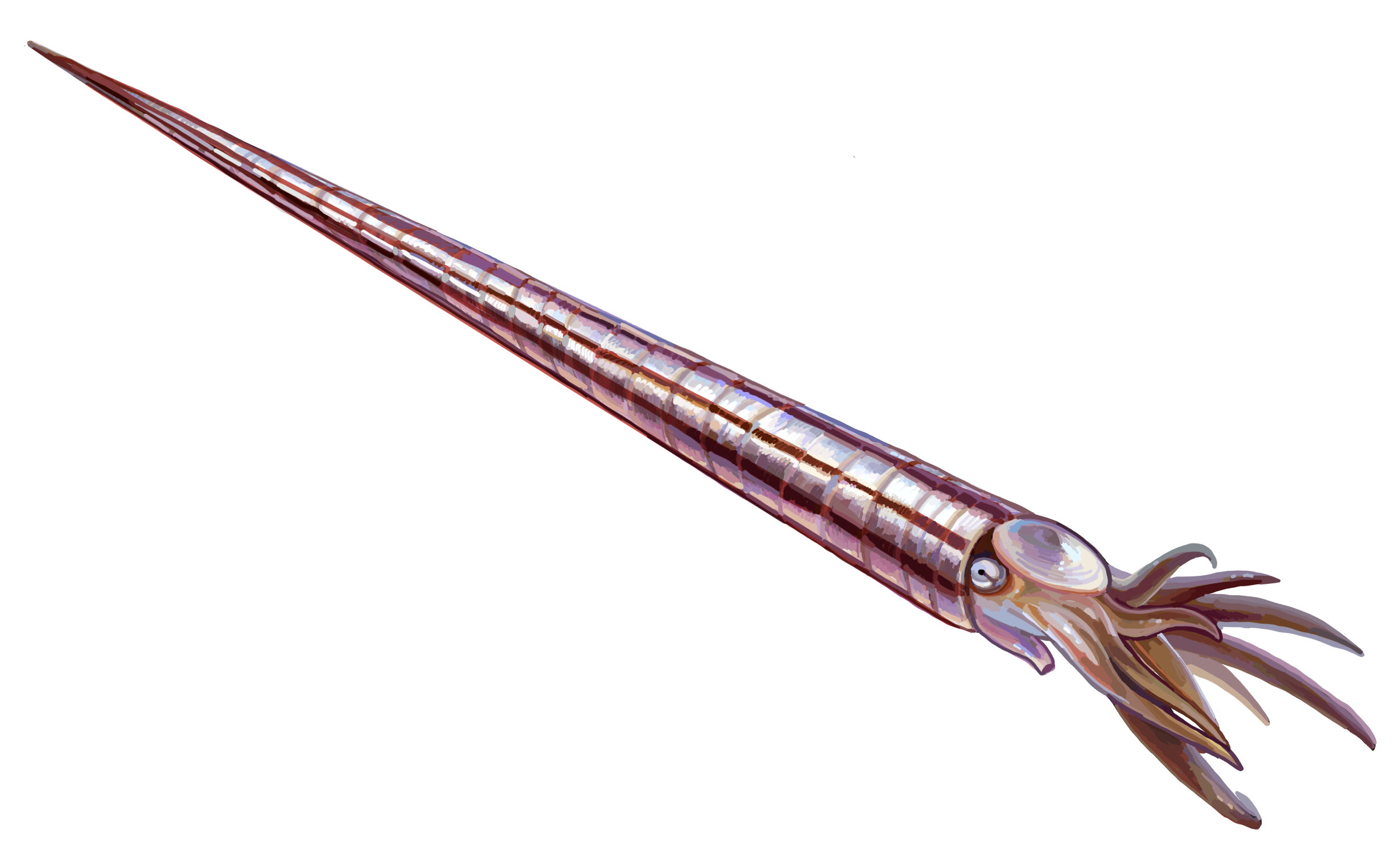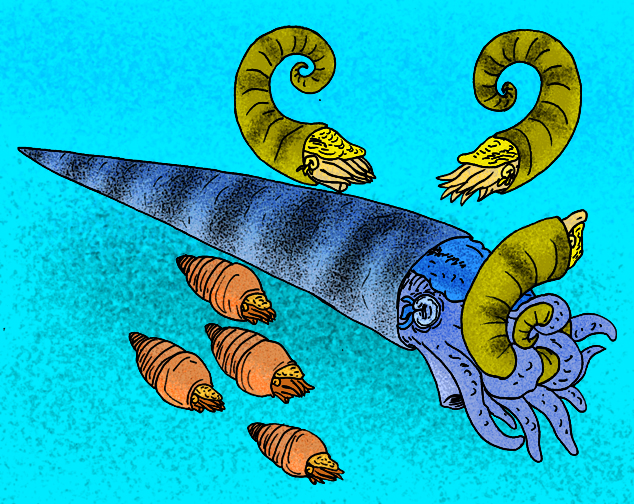|
Endocerid
Endocerida, from Ancient Greek ἔνδον (''éndon''), meaning "inside", and κέρας (''kéras''), meaning "horn", is an extinct nautiloid order, a group of cephalopods from the Lower Paleozoic with cone-like deposits in their siphuncle. Endocerida was a diverse group of cephalopods that lived from the Early Ordovician possibly to the Late Silurian. Their shells were variable in form. Some were straight ( orthoconic), others curved (cyrtoconic); some were long (longiconic), others short (breviconic). Some long-shelled forms like '' Endoceras'' attained shell lengths close to . The related '' Cameroceras'' is anecdotally reported to have reached lengths approaching , but these claims are problematic. The overwhelming majority of endocerids and nautiloids in general are much smaller, usually less than a meter long when fully grown. Morphology Endocerids had a relatively small body chamber as well as a proportionally large siphuncle, which in some genera reached nearly half ... [...More Info...] [...Related Items...] OR: [Wikipedia] [Google] [Baidu] |
Cameroceras
''Cameroceras'', from Ancient Greek καμάρα (''kamára''), meaning "chamber", and κέρας (''kéras''), meaning "horn", is an extinct genus of endocerid cephalopod which lived in equatorial oceans during the entire Ordovician period. Like other endocerids, it was an orthocone, meaning that its shell was fairly straight and pointed. It was particularly abundant and widespread in the Late Ordovician, inhabiting the shallow tropical seas in and around Laurentia, Baltica and Siberia (equivalent to modern North America, Europe, and Asia).Frey, R.C. 1995. U.S. Geological Survey, p.73 ''Cameroceras'' exhibited a broad range of sizes, and some species were fairly large by extinct cephalopod standards. One species, ''C. turrisoides'' from the Boda Limestone of Sweden, is estimated to have shell around in length, while that of ''C. rowenaense'' was about . Some books and older scientific papers previously treated ''Cameroceras'' as the absolute largest nautiloid-grade cephalopo ... [...More Info...] [...Related Items...] OR: [Wikipedia] [Google] [Baidu] |
Bisonocerida
Bisonocerida is an order of Ordovician to Silurian nautiloid Cephalopod, cephalopods. Members of this order were originally placed in the order Endocerida, but later investigation argued that this broad usage of Endocerida was a Polyphyly, polyphyletic assemblage encompassing two different groups of independent origin. Bisonocerida was differentiated from Endocerida in 2012 in order to resolve this issue. Bisonocerids are similar to endocerids in many respects. The siphuncle was broad and positioned ventrally in the shell, which ranged in shape from cyrtoconic brevicones (curved and short) to rare orthoconic longicones (straight and long). The inner surface of the siphuncle contains endosiphuncular deposits, which help distinguish the two orders. In both bisonocerids and endocerids, the endosiphuncular deposits are conical in shape ("endocones"), concreted from the rim of the siphuncle and tapering towards the apex of the shell. Both orders possess simple perforate endocones, with ... [...More Info...] [...Related Items...] OR: [Wikipedia] [Google] [Baidu] |
Allotrioceras
''Allotrioceras'' is a tubular fossil from the Middle Ordovician of the state of New York, collected by Rousseau H. Flower; included by him in the Endocerida and placed in a new family, the Allotrioceratidae. ''Allotrioceras'' is characterized by a lateral pair of subequal conical structures, resembling the endocones of endocerids, separated by a straight partition that extends more than half way across from either the dorsal or ventral side, as perceived, and runs along the length. What remains is thought to represent a siphuncle, which ranges from about 8 millimeters (0.3 in) to about 15 millimeters (0.6 in) in diameter. On the basis of diagnosis, inclusion of ''Allotrioceras'' and the Allotrioceratidae, for which it is the type, in the endocerida seems at best tentative. Some endocerids, derived from the Proterocameroceratidae, ''Najaceras'', '' Cacheoceras'', and '' Williamsoceras'', have a longitudinal dorsal or ventral process, or both about which the endocones ar ... [...More Info...] [...Related Items...] OR: [Wikipedia] [Google] [Baidu] |
Orthoconic
An orthocone is the long, cone-shaped shell belonging to several species of ancient nautiloid cephalopod—the prehistoric ancestors of today's marine cephalopod mollusks, including the cuttlefishes, nautiluses, octopuses and squids.; During the 18th and 19th centuries, all such shells discovered were given the "catch-all" name ''Orthoceras'', thus creating a wastebasket taxon. However, it is now known that many species, genera and families of nautiloids developed or retained this form of shell. An orthocone, loosely, may be thought of as a nautiloid shell, albeit somewhat larger and with a cone-shaped, straight formation as opposed to the nautiloid's coiled, curled shape. It was previously believed that these represented the most primitive form of nautiloid, however, it is now known that the earliest nautiloids had shells that were slightly curved. An orthoconic form evolved several times among cephalopods, and, among nautiloid cephalopods, is prevalent among the ellesmerocerids ... [...More Info...] [...Related Items...] OR: [Wikipedia] [Google] [Baidu] |
Proterocameroceratidae
The ''Proterocameroceratidae'' were the first of the Endocerida. They began early in the Ordovician with ''Proendoceras'' or similar genus which had developed endocones, replacing the diaphragms of the ellesmerocerid ancestor. Proterocameroceratids are long, straight or gently curved with a generally narrow siphuncle along the ventral margin. Septal necks are short, never quite reaching the previous septum and may vary in length ontogenically within a species. Connecting rings are thick and layered. Endocones are simple, especially in early forms but may be complex with secondary structures in later forms. The Proterocameroceratidae gave rise to the Piloceratidae early on, and later to the Manchuroceratidae and Chihlioceratidae, from which the Allotrioceratidae are derived, and later yet possibly to the Emmonsoceratidae and Najaceratidae. The Piloceratidae in turn may have given rise to the Endoceratidae although a proterocameroceratid ancestor remains possible. Proterocamerocera ... [...More Info...] [...Related Items...] OR: [Wikipedia] [Google] [Baidu] |
Nautiloidea
Nautiloids are a group of cephalopods (Mollusca) which originated in the Late Cambrian and are represented today by the living ''Nautilus'' and ''Allonautilus''. Fossil nautiloids are diverse and species rich, with over 2,500 recorded species. They flourished during the early Paleozoic era, when they constituted the main predatory animals. Early in their evolution, nautiloids developed an extraordinary diversity of shell shapes, including coiled morphologies and giant straight-shelled forms ( orthocones). No orthoconic and only a handful of coiled species, the nautiluses, survive to the present day. In a broad sense, "nautiloid" refers to a major cephalopod subclass or collection of subclasses (Nautiloidea ''sensu lato''). Nautiloids are typically considered one of three main groups of cephalopods, along with the extinct ammonoids (ammonites) and living coleoids (such as squid, octopus, and kin). While ammonoids and coleoids are monophyletic clades with exclusive ancestor-desce ... [...More Info...] [...Related Items...] OR: [Wikipedia] [Google] [Baidu] |
Ordovician
The Ordovician ( ) is a geologic period and System (geology), system, the second of six periods of the Paleozoic Era (geology), Era, and the second of twelve periods of the Phanerozoic Eon (geology), Eon. The Ordovician spans 41.6 million years from the end of the Cambrian Period Megaannum, Ma (million years ago) to the start of the Silurian Period Ma. The Ordovician, named after the Celtic Britons, Welsh tribe of the Ordovices, was defined by Charles Lapworth in 1879 to resolve a dispute between followers of Adam Sedgwick and Roderick Murchison, who were placing the same Rock (geology), rock beds in North Wales in the Cambrian and Silurian systems, respectively. Lapworth recognized that the fossil fauna in the disputed Stratum, strata were different from those of either the Cambrian or the Silurian systems, and placed them in a system of their own. The Ordovician received international approval in 1960 (forty years after Lapworth's death), when it was adopted as an official per ... [...More Info...] [...Related Items...] OR: [Wikipedia] [Google] [Baidu] |
Orthoceratoidea
Orthoceratoidea, from Ancient Greek ὀρθός (''orthós''), meaning "straight", and κέρας (''kéras''), meaning "horn", is a major subclass of nautiloid cephalopods. Members of this subclass usually have orthoconic (straight) to slightly cyrtoconic (curved) shells, and central to subcentral siphuncles which may bear internal deposits. Orthoceratoids are also characterized by dorsomyarian muscle scars (a small number of large scars concentrated at the top of the body chamber), extensive cameral deposits, and calciosiphonate connecting rings with a porous and calcitic inner layer. Currently, Orthoceratoidea comprises the orders Riocerida, Dissidocerida, Actinocerida, Pseudorthocerida, Lituitida and Orthocerida. Orthocerida is a noteworthy paraphyletic order which is ancestral to the major cephalopod groups such as the extinct ammonoids and living coleoids (cephalopods without external shells, including squids, octopus, cuttlefish, etc.). Taxonomy As a superorder, ... [...More Info...] [...Related Items...] OR: [Wikipedia] [Google] [Baidu] |
Brachiopod
Brachiopods (), phylum (biology), phylum Brachiopoda, are a phylum of animals that have hard "valves" (shells) on the upper and lower surfaces, unlike the left and right arrangement in bivalve molluscs. Brachiopod valves are hinged at the rear end, while the front can be opened for feeding or closed for protection. Two major categories are traditionally recognized, articulate and inarticulate brachiopods. The word "articulate" is used to describe the tooth-and-groove structures of the valve-hinge which is present in the articulate group, and absent from the inarticulate group. This is the leading diagnostic skeletal feature, by which the two main groups can be readily distinguished as fossils. Articulate brachiopods have toothed hinges and simple, vertically oriented opening and closing muscles. Conversely, inarticulate brachiopods have weak, untoothed hinges and a more complex system of vertical and oblique (diagonal) muscles used to keep the two valves aligned. In many brachio ... [...More Info...] [...Related Items...] OR: [Wikipedia] [Google] [Baidu] |
Endoceratidae
Endoceratidae, from Ancient Greek ἔνδον (''éndon''), meaning "inside", and κέρας (''kéras''), meaning "horn", is a family of large to very large straight-shelled Nautiloidea, nautiloid cephalopods belonging to the order Endocerida that lived during the Middle and Late Ordovician. They include the largest known Paleozoic invertebrates, represented by ''Endoceras'' and ''Cameroceras''.Teichert C, (1964). Endoceratoidea; Treatise on Invertebrate Paleontology, ''Part K, Mollusca 3''.Flower R. H. (May 1958). "Some Chazyan and Mohawkian Endoceratida", ''Jour Paleo'' 32 (2) pp 433-458 Description Endocerids are characterized by large, generally ventral siphuncles with simple endocones which lack the more complex structures associated with the Proterocameroceratidae and their derivatives. Endocones, nested cone-shaped deposits characteristic of the Endocerida, form in the apical portion of the siphuncle where they balanced the weight of the animal in the body chamber at the o ... [...More Info...] [...Related Items...] OR: [Wikipedia] [Google] [Baidu] |



